Ten members met at the 18th century stone bridge, with it’s outwardly curved ends and cylindrical stone pillars in the village of Austwick. An old settlement built on a line of springs and the north and south Craven fault. Listed in the Domesday book as ‘Ousteurvic’, which means ‘eastern dairy farm’; old Scandinavian Austr ‘eastern’ and old English ‘wic’ dwellings or specialised farm.
There is a concentration of datestones from the 1690’s to 1720’s and many uses of Silurian slate, quarried at nearby Helwith Bridge are found here, including footpaths, stiles, gateposts, clapper bridges (the largest collection of well preserved in England are found here); it is also widely used in buildings, roofs, floors, interior dividing walls, shelves in butteries and privy seats.
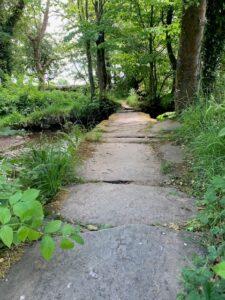
Clapper Bridge Austwick Photo Phyllida Oates
We were given a brief tour of the interesting features of Beck House, which has evidence of several stages of building from 17th Century, with a date of 1761 and initials TA on its front door jamb. A rare survival here is a privy built into the garden wall and overhanging the beck, probably inserted when the house was gentrified in the 19 century.
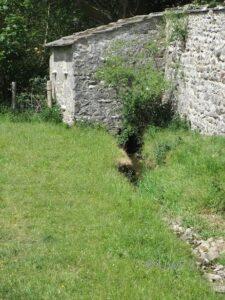
Beck House Austwick Photo Phyllida Oates
Next crossing two clapper bridges, we came to Harden Cottage which has an elaborate door hood with a date stone of 1719 and a large buttress on either side of the south entrance for extra support, due to the Craven fault. On the north side of the cottage, the top right window head has the rare inscription ‘Cheese Room’. Dairies were exempt from the window tax levied from 1696 to 1851.
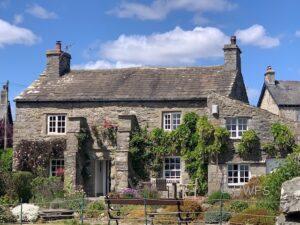
Harden Cottage Austwick Photo Phyllida Oates
The property names paint a good picture of times past: the Smithy, The Cuddy (a small room), Old Joiners shop, The Weaving Shed, The Old School, the Poor House and The Old Reading Room, where the village horse drawn hearse was housed below. Battle Hill with it’s storeyed porch, a curved wall and stone stairs to the upper floor, (a rare feature in the Dales) original studded door and lintel dated 1763 where a skirmish had taken place and Bonnie Prince Charlie is reputed to have stayed.
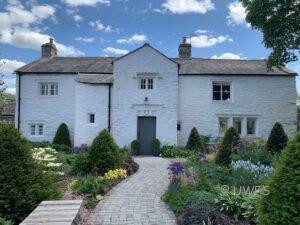
Austwick Hall Photo Phyllida Oates
We were given an interesting talk about the complex changes made to the front of Austwick Hall, previously owned by the Inglebys; cousins to the Ingleby family at Ripley Castle. They contributed generously to the village, including paying for the Church, which was originally conceived as a lecture hall and converted to a church dedicated to the Epiphany in 1839.
Cock fighting took place in a pit between Austwick Hall and The Game Cock Inn, banned in 1835. At one point there were four public houses in the village, which probably led to the building of 3 storeyed Northcliffe House for the Independent Order of the Rechabites, a friendly society founded in 1835 to promote total abstinence from alcohol.
We finished our tour at the lovely village green in front of the Game Cock Inn, where we enjoyed a drink and cake, never having solved the mystery of the blocked window with a large stone on the gable end of the old Post Office
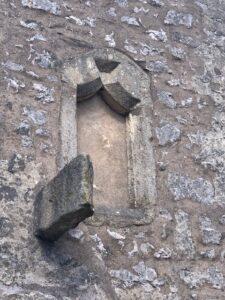
Gable end Austwick Photo Phyllida Oates



